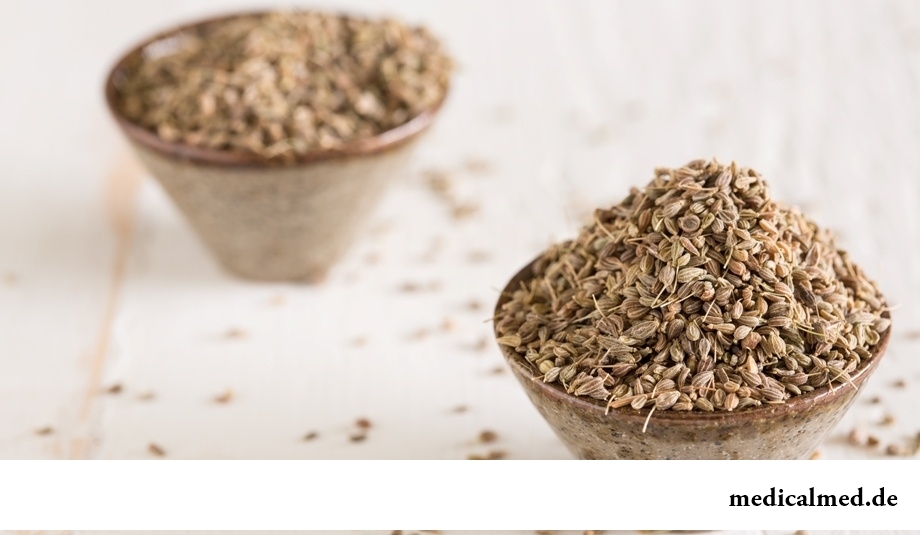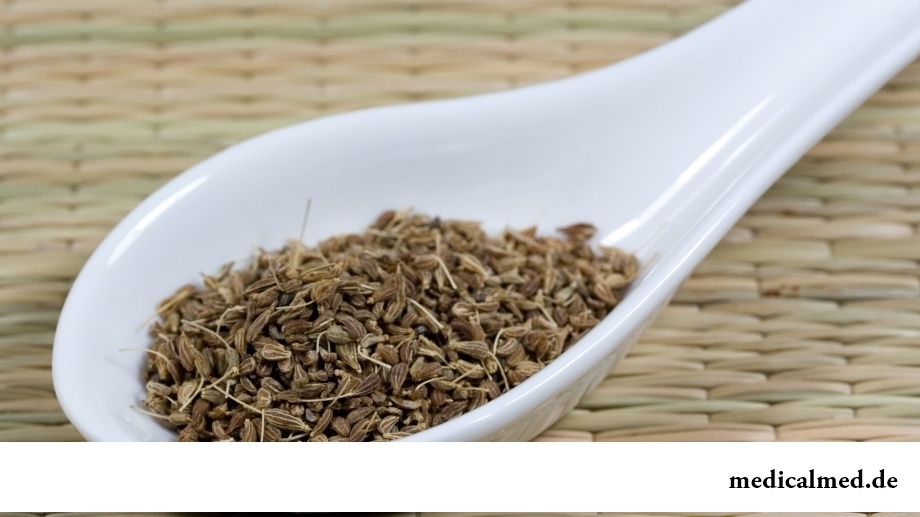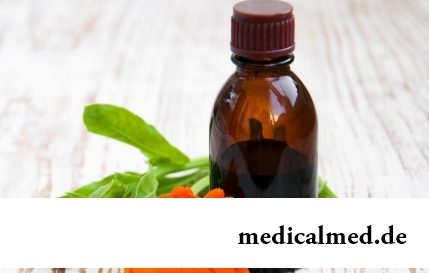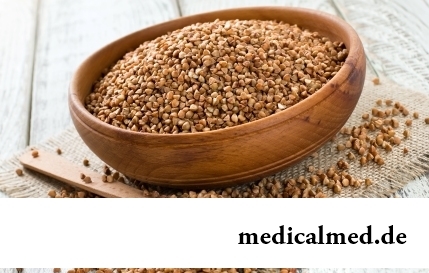





Anise
Medicinal properties of an anise are known since Avicenna and Hippocrates, and as spice grow up it not one thousand years.

Description
Anise – an annual herbaceous plant from family Umbrella. In height it reaches 50 cm. In a wild look grows in Greece, and here cultivate it practically worldwide. In the medical purposes use roots, seeds and a land part of a plant.
Stalks collect during blossoming with even immature fruits. They are cut off and dried in the dry dark place. Fruits (seeds) collect already mature, and too dry in the dark place, spreading a thin layer. Roots of a plant dig out after collecting fruits, in the fall.
The homeland of an anise are Middle Eastern and Mediterranean regions. Began to grow up a plant some more thousands years ago. For certain it is known that in the 1st century B.C. it was grown up in Ancient Greece, Egypt and on the island of Crete. At the time of the Middle Ages the plant extended across all Mediterranean where it was grown up not only as spice, but also as a medicinal plant. Today the anise is cultivated worldwide, but this seasoning enjoys the greatest popularity in Egypt, Southeast Asia, Southern Europe and in the Middle East.
Use of an anise in cookery
Anise fruits in cookery use as spice. They are added to pastries, confectionery and baking products as independent ingredient or in combination with other spices. Add them to tinned fruit and jam, various gravies and sauces to vegetable and meat dishes.
On the basis of an anise prepare Arak, to an elder, absinthe liqueur, mastic and other alcoholic drinks. In east kitchen the anise is often added to tea, fruit soups and infusions for aromatization and a soaking of products.
Do oil which was widely used in confectionery, baking, meat, fish and alcoholic production, and also in soap manufacture of an anise.
Structure and caloric content of an anise
In 100 g of an anise 9,5 g of water, 17,6 g of proteins, 15,9 g of fats, 14,6 g of cellulose, 35,4 g of carbohydrates, 7 g of ashes contain; vitamins: thiamin (B1), Riboflavinum (B2), Niacinum (RR), pantothenic acid (B5), pyridoxine (B6), folic acid (B9), ascorbic acid (C); macrocells: phosphorus, sodium, magnesium, potassium, calcium; microelements: zinc, selenium, copper, manganese, iron.
Caloric content of an anise makes 337 kcal on 100 g of a product.
Advantage of an anise
In traditional medicine an anise ordinary apply as anesthetic, expectorant, sudorific, disinfecting, an antipyretic. Improvement of a vermicular movement of intestines, secretory function of respiratory tracts and digestive tract belongs to useful properties of an anise.
Anise seeds very much are appreciated and are a component of laxative, chest, sudorific and gastric collecting. Thanks to advantage of an anise, it with success is used in the perfumery, alcoholic beverage and food industry.
Decoction from seeds of an anise is applied to treatment of enterospasms, inflammatory processes in digestive tract, at a meteorism, locks, gastric bleedings, painful periods and disturbances of a menstrual cycle and also as means for digestion improvement. At nursing mothers decoction from seeds of an anise improves a lactation.
Infusion of stalks and seeds of a plant improves work of a liver and pancreas. Apply it at cough, bronchitis, asthma, pneumonia, short wind, tracheitis, laryngitis. The curative properties of an anise promoting fluidifying of a phlegm therefore often it is applied at whooping cough at children are known.
Broth of seeds of an anise with honey has good effect at hoarseness of a voice. And at burns use the broth of seeds mixed with ovalbumin.
The advantage of an anise as diuretic at an urolithiasis, diseases of kidneys and a bladder is known.
On the medicinal properties the anise ordinary concedes to caraway seeds and fennel, but it has much more pleasant taste. Therefore from an anise tasty and useful tea turns out.
Do the oil representing yellowish liquid with pleasant spicy and sweet aroma of an anise. Anisic oil is included in structure of chest elixirs, cough drops. Use it as an expectorant and antiseptic agent at treatment of cold and inflammations of upper respiratory tracts (bronchitis, quinsy, laryngitis, cold, flu).

Anisic oil is applied at a scurvy, loss of a voice, burns and inflammatory processes on almonds and gingivas.
One more advantage of an anise is that the smell it is not transferred by insects therefore often it is used at fight against bugs, flies, mosquitoes and louses.
Roots of an anise include in various collecting for improvement of cordial activity. And to get rid of an unpleasant smell from a mouth, they are allowed to chew to smokers.
Contraindications
The anise and drugs on its basis have also contraindications. So, they cannot be applied at stomach ulcer and a 12-perstny gut, pregnancy, ulcer colitis, at a hyperoxemia of a gastric juice, and also to children up to twelve years.
Treatment duration anisic oil should not exceed seven days. Besides, at the long or excessive use broth and infusion of an anise can cause allergic reaction.
The well-known drug "Viagra" was initially developed for treatment of an arterial hypertension.

Practically each person is familiar with the annoying, pulling, unscrewing pains caused by overcooling of muscles of a back. In некото...
Section: Articles about health
Doctors claim that the people not so familiar with a dorsodynia occur among adult Russians very seldom. At the same time the vast majority of the patients who are periodically testing this indisposition do not hurry to ask for medical care at all. With one St...
Section: Articles about health
The winter swimming in open reservoirs called in our country by "winter swimming" – officially recognized sport and one of the most extreme ways of a hardening of an organism. This occupation has an old story and adherents in many countries. The international competitions in winter heats on open water, and every two years – the World Cup are annually held. Despite huge popularity and the proved advantage for health, winter swimming is still surrounded with hardy delusions. Ра...
Section: Articles about health
Frosty air, fresh wind and easy snowball at most of Russians are associated with cheerfulness, health and cheerful entertainments, on to...
Section: Articles about health
Neurosis is called pathology of a nervous system at which deviations in functioning of the highest nervous processes are observed. Most often - owing to yet not strengthened mentality - children are subject to neurosises. Premises to emergence of such disturbances can become нез...
Section: Articles about health
Each failure in work of bodies and systems of a human body is, as a rule, shown by the whole complex of symptoms. In particular, malfunctions with health often cause emergence of cosmetic defects in the form of rashes on a face. Experienced doctors know that localization of heat-spots usually depends on what disease the patient has....
Section: Articles about health
The pancreas performs two functions in a human body: release of enzymes without which digestion carbohydrate is impossible...
Section: Articles about health
No, probably, the person who would not have cold. Cold, cough, a headache – these symptoms are known to everyone. The peak of catarrhal diseases is the share of fall. SARS already came to schools and kindergartens, flu slowly makes the way to the cities, in a word, з...
Section: Articles about health
What will only not be thought up by persons interested to have a beautiful figure. Here the last innovation – for weight loss needs to be eaten greasy food. Let's understand whether there is at a fatty diet common sense....
Section: Slideshow
The naturopathy sometimes moves as the new direction of medicine, something like fashionable hobby, and there is nothing farther from the truth....
Section: Articles about health
All know that self-treatment is dangerous. However absolutely it is almost impossible to do without it. Rate of modern life does not allow to handle each small trouble to the doctor and information on ways of independent rendering medical the help...
Section: Articles about health
The metabolism at each person proceeds in own way. However between the speed of this process and disposal of excess weight after all all have a dependence. Unfortunately, the people inclined to try on itself numerous "miracle" diets, not always consider this circumstance and with the most resolute intentions begin to eat so that artificially slow down the metabolism instead of to accelerate it. Except quite clear disappointment, incorrectly picked up systems...
Section: Articles about health
Osteoporosis this general disease which main sign is decrease in density of a bone tissue. On width распростран...
Section: Articles about health
Musicotherapy – a treatment method which caused and causes a set of a controversy concerning its efficiency. However the facts are relentless: during the numerous researches curative impact of music on an organism was scientifically confirmed. Since then in a number of the countries a method...
Section: Articles about health
Dark circles (bruises) under eyes – a shortcoming with most of which often fight against the help of cosmetics (proofreaders, saloon procedures and so forth), eliminating only its visibility. However, according to doctors, skin around eyes – the indicator of many disturbances in an organism. To reveal them at early stages, without having disguised bruise, and having addressed its reasons – a task of each person who is regularly finding under with own eyes dark stains. Early detection and elimination of the disease lying in wasps...
Section: Articles about health
Cystitis, or inflammation of a mucous membrane of a bladder, this very widespread disease, which, owing to some persons...
Section: Articles about health
Shops of household appliances offer us the huge choice of various devices for the house. Whether there are among this abundance devices which not only facilitate house work, but also help to keep health of the person? Of course, and we will tell about them today....
Section: Articles about health
The cosmetics intended for improvement of a condition of skin, nails and hair are used by each woman. Expenses on regular acquisition of the fashionable widely advertized products of well-known companies for many become very notable and significantly burden the family budget. Meanwhile, there is a number of inexpensive pharmaceutical drugs which can quite be applied in the cosmetic purposes. At the same time the effect of their use is often more noticeable, than result of use of the most expensive...
Section: Articles about health
Epilepsy is one of widespread neurologic diseases. To parents, whose children suffer from this illness, it is necessary...
Section: Articles about health
The medicine promptly develops, and the fact that else quite recently it seemed by miracle can now. We are not surprised any more to the fact that people with artificial joints and extremities can play sports, organ transplantation became a routine, and the latest cancer medicine п...
Section: Articles about health
Run - one of the most available and effective ways to revitalize the organism. Knowing about its extraordinary advantage, each of us at least once tried to make jogs, but only the few made these occupations regular. In spite of the fact that in jogging (easy jogging), apparently, there is nothing difficult, the beginning runners often make mistakes which lead to complete cessation of trainings. Let's consider 10 useful tips for beginners who will allow them to make regular п...
Section: Articles about health
The body of the person almost for 60% consists of water. It is so important for normal functioning of an organism that loss of all is ponut...
Section: Articles about health
The way of life of people promptly changes from year to year: if about ten years ago the personal computer was not in each family, then today already very few people do without this device. Certainly, and children master the computer at full speed: they not only I play...
Section: Articles about health
For many women the word "fat" sounds as a sentence. In aspiration to an ideal figure they try to exclude, first of all, from the menu all dishes containing fats without having at the same time a clear idea of a role of these substances in exchange processes, and of effects for health with which food restrictions of this sort are fraught. For what the human body needs fats and as their deficit in a diet is shown, we also will try to find out....
Section: Articles about health
History of cultivation of a buckwheat contains more than five thousand years. Grain which is received from this plant is used for пригото...
Section: Articles about health
Each woman has preferences in the field of use of those goods which help us to look good, feel young and effective. Besides: selection process of favourite perfume, shampoo or decorative cosmetics already lifts a spirit...
Section: Articles about health
Obesity is called a disease of 21 centuries, for the last 100 years the number of the people suffering from excess body weight considerably increased. Statistically, on Earth already about 1,5 billion corpulent people, and 500 million from them have the extreme degree of completeness negatively affecting quality and duration of their life. What served as the reason of growth of stout persons on the planet? How not to get to their ranks? Let's consider five main premises for increase in body weight in conditions современнос...
Section: Articles about health
